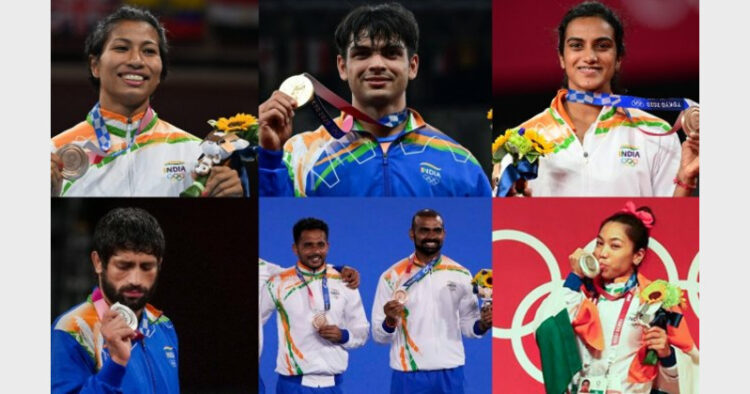Not long ago, what was India's story with Sports? When the Indian contingent returned empty-handed from the Olympic Games every four years, there would be no post-mortem examination of the failures. But the story has changed in 2021.
New Delhi: Two northeastern women proved that 'New India' has arrived.
Manipur's weightlifter Mirabai Chanu used to take lifts from unknown truckers to go to the stadium for practice. She won the Silver medal on the opening day of the Tokyo Olympics. Assam's Lovlina Borgohain was another star who won a bronze in women's welterweight (69kg).
Of course, so did others. Neeraj Chopra has redefined 'javelin' for millions of Indians. His admirers later wrote that Neeraj Chopra used ten precious seconds of his life to end India's 121-year wait for a track and field medal at the Olympics. P. V. Sindhu bounced back from a disappointing semi-final loss to pick up Bronze and become the first Indian woman to win multiple Olympic medals.
India is a changed nation in sports today. 'Naya Bharat' as envisioned by its dreamer, Prime Minister. Conventionally, one could call it 'fire in the belly' – a salad of a powerful sense of determination and ambition for any competitor.
Indians were happy to believe in the old dictum that one could win or lose, but the game is important. The show must go on, etc. And for officials and coaches, these events used to be for shopping and tourism bonanza.
Now it's different. This is 2021. For the first time since its independence in 1947, the nation of 1.3 billion people finished with seven medals, including a coveted gold in the men's javelin throw. The Indian men's hockey team made history by claiming an Olympic medal after 41 years. Overall, India finished 48th among the participating nations.
There were fairy tales in the entire show. Indian women's hockey captain Rani Rampal's father pulled a hand-cart, and his mother worked as domestic help. There are others with similar stories of poverty to medals and social respectability.
"I always wanted to see an Indian win an Olympic Gold (in athletics)," said a proud sprinter, P T Usha, who had finished fourth and missed Bronze in the 1984 Los Angeles track event.
It was 'Olympic fever' for days in a nation – which looked demoralised, fighting COVID-19 and the pandemic-inflicted economic crisis and joblessness.
But there are a few vital underlining messages from the moments of sporting glory for India, and thus a few important lessons. One important takeaway is that Tokyo2020 marks the emergence of the underdogs. But the bigger message would be that the Sports have proved to be a tool of great social metamorphosis for a country of 135 crores plus, which was satisfied till now of not winning any medal for years.
The 'revolution' also meant a few bigger stories — fighting two 'almost permanent' malaise – Poverty and Patriarchy. The year 2021 and Tokyo2020 marked a major and positive turning point more from India's social point of view.
"This is now an era of underdogs and underprivileged. Women have fought patriarchy, especially in Haryana, and a host of hockey players and others are in sports essentially in search of a better life," wrote one sportswriter.
Unlike cricket stars from Delhi and Mumbai, the young boys and girls in athletics often are homeless. Few stayed in mud houses. Sports was a game-changer in 2021.
For a long time, Indian boys and girls focused on the classroom, aiming to be doctors, engineers, and bureaucrats with easy to live jobs. The Indian education system still values the ability to mug up. Sports was never important for the educated middle classes.
In Haryana, the society is generally of conservatives and male chauvinism. The state recorded a lopsided sexual demographic in 2012 where there were just 877 women to every 1,000 men following years of infanticide and abortions. There was a marginal improvement in 2020. Now the state has 922 girls for every 1000 men. It was not easy to do well in sports for young girls braving these social hurdles and tough conditions.
In Haryana, parents want young girls to wear Salwar-Kameez (an outfit that covers the entire body) and return home before dark. There would be Khap-panchayats (kangaroo courts) in villages passing diktats on women's attire and discussing girls' matters in public places and marriages.
However, enthusiasm and new dreams defined people's approach. This was exemplified by the players' performance and the encouragement they got in the run-up to the sporting extravaganza, especially from parents and various sporting bodies.
Gold medalist Neeraj Chopra, in-service defence personnel, also comes from a little known village Khandra in Haryana, and his father has been a humble farmer.
There is also a paradox. Despite patriarchy issues and conservative social structure, 25 per cent of India's athletes in the Olympics were from Haryana in 2021. The state's population is a little over 2 per cent vis-a-vis the national figures.
Another woman hockey player, Parasdeep Kaur, says people tell her father that she should be married off without further delay. Little wonder she is the only one pursuing the game from her village.
Bronze winner boxer Lovlina Borgohain hails from a development-starved place called Sarupathar in Assam adjoining the Nagaland border.
Politically, Congress has ruled India and the states for decades. The Leftists remained permanent self-styled virtuous and efficient lots.
In states such as West Bengal, there has been a serious job crisis for years. The answer is 'Unemployment fees (Bekar Bhata)'; they never considered sports a viable alternative to encourage youngsters.
2021 would mean different things to sports and Indian sports lovers.













Comments